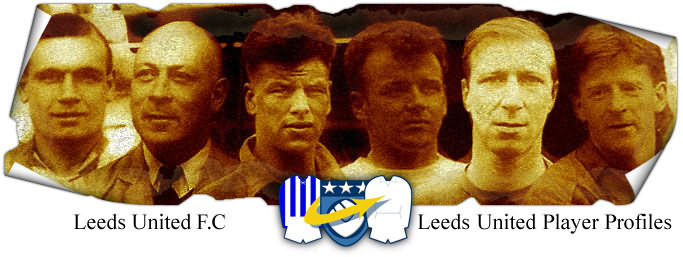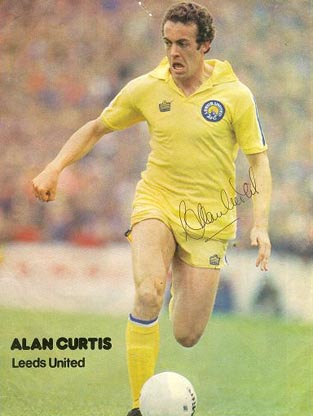

Curtis: Alan Thomas (Alan)
1979-1980
(Player Details)
Forward
Born: Ton Pentre, Nr Pontypridd: 16-04-1954
Debut v Bristol City (a): 18-08-1979
5’11” 12st 71/2 lb (1979)
Alan Curtis had three spells with Swansea City in his eighteen year career during which
time the club lurched from lows to highs and back again in manic style. In that time Curtis
undoubtedly established himself as one of the club’s true legends. Curtis joined Swansea as
an amateur in 1971, after starring in a Welsh Youth trial at Tonyrefail and after completing
his education at Porth Grammar School he turned down a chance to join Tottenham Hotspur to
sign professional with Swansea a year later, in July 1972. He first broke into the Swansea
side in the 1972-73 season and the promising youngster was given an immediate taste of the
turbulence that lay ahead as the club suffered relegation into the Fourth Division. In
Division Four Curtis immediately began to prosper even though his club continued to struggle.
The only question mark concerning the talented youngster was how best to utilise his skills,
as he was picked for the Welsh Under-Twenty-Three and Under Twenty-One sides. He then earned
his first Welsh Cap on 24th March 1976, when England won 2-1 at Wrexham, with Curtis scoring
on debut with a goal in the final minute. In 1977 the club missed out on promotion by a single
point but the next season things really started to happen for both Swansea and Curtis. Curtis
banged in six goals in the first six games and didn't stop scoring all season. By the end of
the season Curtis had managed thirty-two goals in just thirty-nine games and Swansea had won
promotion. The following season the Swans were promoted once more with Curtis again prominent.
His quicksilver skills seemed vital to the team's further progress as Toshack bolstered his
side with a host of solid, experienced campaigners but, after turning down several requests
from other, larger, clubs as Curtis won the award for best player in the Division in 1976-77,
and continued his international career by appearing in all three home internationals, he
surprised Toshack by asking for a transfer, citing a wish to play First Division football. So,
at the end of the season, he was sold to Leeds United for £370,000, in May 1979. It was a
record for a Third Division Player. In his first spell at the Vetch Field he had scored
seventy-two goals in two hundred and forty-eight League appearances. Although he could have
gone to Crystal Palace and despite heading some miles north, Elland Road was still a bit of a
home from home for Rhondda-born Curtis, with fellow Welshmen Byron Stevenson, Brian Flynn,
Carl Harris and Gwyn Thomas already residing there. It seemed a surprising move by the club
and a potential poisoned chalice for Curtis but, in a round about way, the move would work out
nicely for both. Curtis struggled to make an impression at Elland Road, although it might be
unfair to label him a failure at the club. Leeds were a team struggling to maintain their place
among the country's elite, at this time, as the last remnants of their great sides of the
Sixties and Seventies disappeared. All around the side holes had appeared which had not been
adequately filled. There is no doubt that Curtis also was not of the calibre of player who had
graced Elland Road in the recent past, but he still showed enough flashes of quality to suggest
that he might have flourished had he stepped into a stronger side. The flamboyant and popular
Tony Currie had just left the club and Curtis was billed as the man to take his place. His
debut was certainly encouraging, scoring both of his side's goals in a 2-2 draw at Bristol City
on 18th August 1979, and a month later, on 11th September 1979 he scored for Wales in a 2-1 win
over the Republic of Ireland at the Vetch Field. Two more Caps followed quickly, as he scored
his country's only goal in a 1-5 reversal to West Germany in Cologne on 17th October 1979 and,
on 21st November 1979, he played in a 0-1 defeat by Turkey at Izmir, both games being in 1980
European Cup Qualifiers. He also scored a memorable goal on 27th October 1979, at Southampton,
who were a good side then, in which he ran half the length of the field to score and won the
award for "Goal of the Month". But there were not enough highlights to follow and he had an hard
act to live up to, in Currie. Adding to his problems in establishing himself was a serious knee
injury which sidelined him for the second half of his first season there. It happened in a Third
Round F.A. Cup-tie with Nottingham Forest, on 5th January 1980, when his knee ligaments were
severely damaged in a collision with Peter Shilton and he was sidelined for eight months.
Although he scored within twenty seconds of the start of his first UEFA Cup match, in Valletta,
against Valletta of Malta and did play in all four of United's UEFA cup games, they were before
he suffered the injury and he was unable to command a regular place on his return.
He sat on the sidelines as the Leeds fans grew more and more upset by Manager Jimmy Adamson's
tactics and he got more and more frustrated at not being able to justify his large transfer fee.
The new season saw Leeds lose six of their opening seven games. Adamson quit and Allan Clarke was
left to clean up the mess. Curtis had scored once in six games, the winner in a 1-0 home win over
Everton on 11th October 1980, Leeds' eleventh game of the season, and Curtis pulled on the Leeds
shirt for the last time, the following week, in a 1-2 defeat at Molineux by Wolverhampton
Wanderers. Clarke had decided that he cut his losses and not gamble on Curtis' fitness and in
December 1980 he sold Curtis back to Swansea for a cut-price £165,000. Inevitably Curtis scored
on his debut for Swansea in his second spell there, scoring an early goal from the penalty spot
on 16th December 1980. Curtis found himself back at the Vetch Field chasing promotion to the
First Division with Toshack's Swansea, who had made a neat £200,000 profit in bringing their
lad back home. Despite a poor run shortly after his return, the club bounced back strongly to
clinch promotion to the top flight for the only time in their history. This completed the
amazing journey from Fourth Division to First under Toshack. Swansea's opening fixture in the
First Division was a home game against Leeds United. The Swans demolished Curtis's former
club 5-1 after a stunning second half display which saw debutant Bob Latchford claim a
hat-trick. No goal was sweeter to the home fans, or more galling to Leeds, however, than the
stunning second-half strike from Curtis. He cut in from the right flank before bamboozling
Trevor Cherry ahead of firing an unstoppable rocket home in front of thousands of aghast
United followers. It provided the coup de grace for Toshack’s troops with a brilliant fifth
goal, although Leeds were well beaten before then. Swansea were unable to maintain this
momentum, however, and suffered relegation the following season with Curtis again hampered by
injury. Then, in a farcical beginning to life back in Division Two, the team struggled,
Toshack resigned, Curtis was sold to Southampton, for £80,000, and Toshack was reappointed,
all before Christmas. The Swans had sold several of their star players due to financial
problems and the season would end with them relegated again. Curtis was once more unable to
truly settle away from Swansea and, as at Leeds, he was not helped by niggling injury concerns.
In his second season at the Dell, Curtis did manage to hold down a first team place with some
regularity, operating as a schemer behind the strikers or out wide. Now into his thirties,
however, and losing the pace off the mark which had been such a potent weapon, and after a
loan spell with Stoke City in March 1986, in which he played three League games without scoring,
he was obliged to move back down the Divisions in June 1986 with a move to Swansea's arch rivals
Cardiff City, On a free transfer. He had scored five goals in fifty League games with the Saints.
There are not many people with links with Swansea City who can find a welcome at Ninian Park,
and few people are more strongly linked with the Swans than Curtis, but he managed to win over
the Cardiff fans with his skill and obvious commitment. Curtis was a regular for the next three
seasons and helped the club to promotion in the second of these. After scoring ten goals in one
hundred and twenty-five League games, and with Cardiff in financial turmoil and struggling at
the foot of the Third Division, Curtis moved back to Swansea in October 1989 to see out the
rest of his final season at his spiritual home, bowing out of football after the final day,
in June 1990. He scored three times in twenty-six League games in that third and final spell
with the Swans. He played non-League with Barry Town as Player-Coach and then signed for
Haverford West County in July 1991. Along the way Curtis had been involved in several European
campaigns courtesy of the Welsh Cup and he also participated in one UEFA Cup campaign with
Southampton and another with Leeds. On top of this he won thirty-five caps for Wales over an
eleven year period. Despite this and his two spells in the First Division with English clubs
Curtis's star never truly shone with much brilliance outside of South Wales. He became Swansea
City’s Football in the Community Officerbefore becoming the club's Youth coach in 1996. He also
had a couple of years as the club's Assistant Manager before becoming the club's head of Youth
Development. He linked up with his former Manager, John Toshack, in December 2004, to overhaul
the Welsh National coaching set up. Brian Flynn was installed as Manager of the
Under-Twenty-One, Under-Nineteen and Under-Seventeen teams, with Curtis and Joey Jones his
Assistant Managers. He is the nephew of Roy Paul, the former Manchester City and Wales Star.